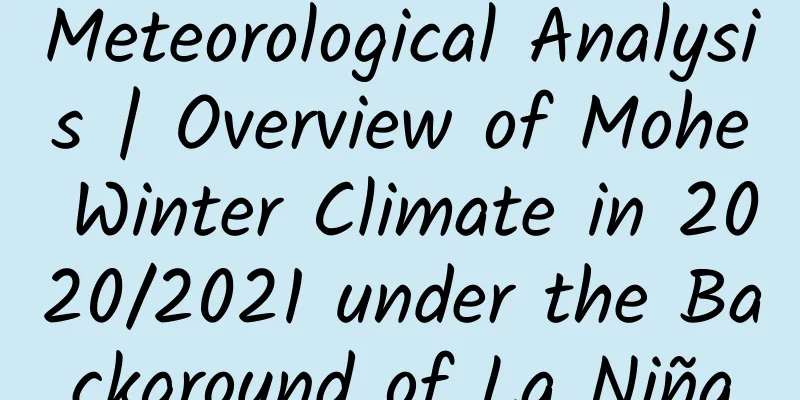Meteorological Analysis | Overview of Mohe Winter Climate in 2020/2021 under the Background of La Niña

|
Text/Photo by Wu Shusen La Niña is a climate phenomenon opposite to El Niño. It refers to abnormal sea surface temperatures in the equatorial central and eastern Pacific Ocean, with a large area of cold water, and the intensity and duration meet certain conditions. For China, the probability of a cold winter has increased. Since 1950, there have been 16 La Niña events in the world. Starting from August 2020, La Niña events occurred again, reaching a peak in November 2020 and ending in March 2021. According to the statistical standards of the National Climate Center, the qualitative characterization of cold winters and warm winters requires consideration of the average temperature for three consecutive months from December of the previous year to February of the following year, so as to determine whether the entire winter is a warm winter or a cold winter. On March 3, 2021, the National Climate Center officially announced that the winter of 2020/2021 (December 1, 2020 to February 28, 2021) was a warm winter, with an average temperature of -2.5℃ nationwide, 0.8℃ higher than the same period of the previous year (-3.3℃), and the eighth highest in the same period since 1961. However, Mohe, China's "Arctic" known for its coldness, has experienced the coldest winter since this century, and has spent a winter different from the rest of the country. 01. Atmospheric circulation situation in winter 2020/2021 The main characteristics of the atmospheric circulation from December 2020 to February 2021 are: the polar vortex in the Northern Hemisphere is dipole distributed, and the polar vortex centers are located near the Queen Elizabeth Islands in northern Canada and in the Russian Far East near the Sea of Okhotsk. Among them; the polar vortex near the Sea of Okhotsk is relatively strong in December (see Figure 1a), the polar vortex in January is stronger than the same period of previous years as a whole (see Figure 1b), and a low vortex split from the polar vortex in February and is located over central Siberia (see Figure 1c). Figure 1 The mean 500hPa geopotential height field in the Northern Hemisphere from December 2020 to February 2021, (a) is December, (b) is January, and (c) is February The polar vortex is the "culprit" and "black hand" behind the cold winter and cold waves in my country. In winter, the polar vortex that originally hovered over the Arctic carried a large amount of cold air southward, affecting the northeast and central and eastern parts of my country. The cold wave weather is related to the "out of the circle" of the "polar vortex", especially the "all-round" cold air that appeared at the end of January this year, which became a nationwide cold wave process. In December 2020, the mid- and high-latitudes of Asia were high in the west and low in the east, with a large circulation direction. The East Asian trough was significantly stronger and deeper than usual, and the cold air affecting my country was significantly stronger. Most of northern my country was controlled by negative anomalies, and the trough was broad and deep, which was conducive to the southward movement of cold air. In January 2021, a high-pressure ridge developed near the Ural Mountains, the East Asian trough was westward and stronger than the same period of previous years, the mid- and high-latitude circulation in Asia had a large meridional direction, and the northeastern part of my country was controlled by the trough area. Affected by this, cold air activities were frequent in the northern region, and the temperature was significantly lower than the same period of previous years. In February 2021, the intensity of the polar vortex in northern Siberia was significantly weaker than usual, but in the middle of the month, the low vortex in the Kara Sea gradually moved eastward and split into a cut-off low pressure located in the northwest of Greater Khingan Range, with a negative anomaly at its center. As the low-pressure system continued to move eastward, the high-altitude trough brought a moderate-intensity cold air process to my country's northern region. 02. 2020/2021 Mohe Winter Temperature Overview Mohe is located in the northernmost part of China and has a cold temperate continental monsoon climate. In winter, under the control of the polar continental air mass and the Mongolian high pressure, it is extremely cold and has a long cold period. Extremely cold weather below -40℃ and blizzards often occur. Against the backdrop of global warming, the temperature in Mohe has been warming since the 1980s. The average winter temperatures in each decade are as follows (see Table 1): Although the climate has obviously warmed up, for Mohe, which is located in the cold temperate zone, the coldness will not change, and it is still the coldest region in the country. Climate warming does not mean that there will be no cold winters, and extreme weather often occurs. From the comparison with the average winter temperature of previous years and the average of the same period in the past 20 years, it can be seen that the average winter temperature in Mohe in the past 60 years is -27.2℃, the average of the same period in the past 20 years is -26.2℃, and the average temperature in the winter of 2020/2021 is -27.0℃, which is only 0.2℃ higher than the average of the same period in previous years, and 0.8℃ lower than the average of the same period in the past 20 years (see Table 2). From the temperature trend, it can be seen that there are significant fluctuations in temperature within the season, and the temperature is first high, then low, and then flat. Among them: the average temperature in December 2020 was -25.3℃, 2.7℃ higher than the average of the same period in previous years; the average temperature in January 2021 was -31.2℃, 2.0℃ lower than the average of the same period in previous years, and 3.4℃ lower than the average of the same period in the past 20 years, ranking third in the past 20 years; the average temperature in February 2021 was -24.4℃, the same as the average of the same period in previous years. According to the 30-year climate standard average value from 1971 to 2000 stipulated by the World Meteorological Organization, the 30-year winter climate average value of Mohe is -24.5℃, and the average temperature anomaly in the winter of 2020/2021 is -2.5℃. "GB/T 33675-2017 Cold Winter Grade" stipulates that cold winter is divided into weak cold winter and strong cold winter. According to the classification standard, the average temperature anomaly in the winter of Mohe in 2020/2021 is ≤-1.29a, so it is a strong cold winter. 03. Temporal and spatial distribution of extremely cold weather below -40℃ According to the "Cold Degree Scale" developed by meteorological professionals, the temperature ranges from below -40℃ to 9.9℃, and is divided into eight levels from low to high. The number of times each level of temperature appeared in Mohe this winter is as follows (see Table 3): After the beginning of winter, extremely cold weather frequently occurred in Mohe City, and the Mohe Meteorological Bureau issued four cold wave warning signals. According to observations and statistics from the national meteorological observation stations and unmanned automatic stations in Mohe, from December 12, 2020 to February 28, 2021, all stations in the city experienced extremely cold weather below -40℃, with an average of 13 times of extremely cold weather in the city, mainly concentrated in December 12-16, December 26-28, January 4-7, January 14-15, January 19-22, January 28-February 4, and February 15-17. This winter, the extremely cold weather in Mohe has a wide range and lasted for a long time, but the temporal and spatial distribution is uneven. The number of extremely cold weather occurrences at each station varies significantly. The most frequent occurrences were in Luoguhe, with 29 times, and the least frequent occurrences were in Beiji Village and Guanyin Mountain, with only 5 times. Mohe Station (Xilinji Town) had a total of 16 occurrences, including 2 times in December 2020, 10 times in January 2021, and 4 times in February. The number of extremely cold weather occurrences at each station is shown in Table 4 (Note: March data is not included because March is not winter): There are also obvious differences in the temperature of extremely cold weather throughout the city. The lowest temperature extreme value appeared in Amur at -49.7℃, the lowest value in Mohe in the past 50 years, and Guanyinshan was only -44.3℃, with a difference of 5.4℃ between the two stations. The lowest temperature at Mohe Station (Xilinji Town) was -46.2℃, the lowest in the same period in the past 22 years (-47.5℃ on January 6, 1998). The lowest temperature extreme values and occurrence dates of each major station are shown in Table 5: On February 13, 1969, the lowest temperature in China was -52.3℃ in the Arctic Village, while this winter the lowest temperature in the Arctic Village was only -45.2℃. It is conceivable that if there were other stations in Mohe at that time (Huzhong established a meteorological station in 1970), the lowest temperature in China might not have occurred in the Arctic Village, and the lowest temperature value might have been even lower. 04. Overview of winter precipitation in Mohe in 2020/2021 The winter precipitation was 30.9 mm, ranking sixth in the same period in history, 14.2 mm more than the average of the same period in previous years, and 12.8 mm more than the average of the same period in the past 20 years. Among them, December was significantly less, January was significantly more, and February was abnormally more, ranking first in the same period in the past 20 years. In February, there was one heavy snow and one heavy to blizzard, which was the main reason for the significantly more winter precipitation (see Table 6). The maximum snow depth at Mohe Station was 50 cm, ranking second in history (53 cm in 1963). 05. Extreme cold weather causes ice fog "Ice fog" is different from the water vapor fog in summer. This weather phenomenon unique to the cold temperate zone has never been heard of by people in the south, and even many meteorological workers have never known about it. Ice fog is a fog composed of a large number of tiny ice crystals suspended in the air. It is formed by the condensation of water vapor in the air. It is a sign for people in high-altitude cold areas to identify extreme temperatures. It is common in winter in cold areas. Ice fog usually appears below -40℃, at night and in the early morning when the air is dry and cold, there is no wind or breeze, and the sky is cloudless. Sometimes it lasts until noon before dissipating. Extreme cold weather is often accompanied by ice fog. The lower the temperature, the more ice fog appears and the lower the visibility. Ice fog is a double-hazardous and extremely severe weather that can have a very adverse impact on transportation, electricity, communications, heating, water supply, production activities and health. Mohe is located in the northernmost part of China. It has a long winter, short days and long nights, and an extremely cold climate. It is known as the "high-altitude cold restricted area" and is the place where ice fog occurs most and lasts the longest. In this extremely cold and harsh ice fog weather environment, it is very likely to cause power outages, water outages, gas (heating) outages, and outages, which will directly affect people's normal life and work, and even endanger people's lives and social stability. Therefore, the local government and relevant departments should attach great importance to it and formulate corresponding emergency measures. 06. Extreme cold weather meteorological service conditions The Mohe Meteorological Bureau attaches great importance to the extremely cold weather in winter. In line with General Secretary Xi Jinping's important instructions on meteorological work, "precise monitoring, accurate forecasting, and meticulous services", the meteorological department plays the role of the first line of defense in disaster prevention and mitigation, and goes all out to monitor, forecast, and provide services for extremely cold weather. According to weather changes, the three-level linkage of provinces, cities, and counties is strengthened, early warning information is released in advance, and meteorological services are provided to local governments, transportation, water supply, power supply, publicity and other departments in a timely manner, and three issues of "Special Report on Major Meteorological Information" are released. The meteorological department is working together to carry out publicity through multiple channels, making full use of TV weather forecasts and the "Mohe Meteorological" WeChat platform to release information on extremely cold weather and popular science knowledge. The special extremely cold weather information produced by our bureau in the form of pictures, texts, videos, etc. has become a hot search. The extremely cold weather in Mohe has been reported by more than 20 media including CCTV 1 and 2, Heilongjiang TV, Xinhuanet, Chinanews.com, Sohu.com, and the website of the China Meteorological Administration, which has attracted widespread attention from the society. |
<<: A brochure on high blood lipid diet for the elderly
Recommend
16 negotiations for 2 seconds! That night 25 years ago...
2 seconds, 23 seconds, 12 seconds There is a stor...
I didn't expect that you've been riding your bike wrong all these years.
China is a kingdom of bicycles. If you observe fo...
What is the form of Tik Tok advertising promotion? Analysis of the characteristics of the Tik Tok platform!
Tik Tok is a music short video community focusing...
A profound question: What is equality?
Before we really get into mathematics, our parent...
2019 Fliggy 3rd Anniversary Event Planning and Promotion Plan!
This article mainly wants to share with you my pe...
iOS 11's 6 major App Store upgrades, are developers ready?
iOS 11 eliminates all non-64-bit chip devices, wh...
Information flow promotion optimization strategy, do this well to achieve 80% success!
Seeing the world through our eyes is an innate ab...
Cartoon | Will you be "genetically modified" if you eat genetically modified food?
Will eating genetically modified food make you &q...
Can laughing help you lose weight? People all over the world laugh like "hahaha"?
Can laughing help you lose weight? Laughing more ...
What’s more frightening than eating too much during the Chinese New Year is that the foods you thought were fat-reducing may actually be useless…
The New Year is coming soon There must be a lot o...
The only survivor of Jixi sour soup poisoning has passed away. How long can sour soup be preserved?
The "sour soup" poisoning incident that...
They look like "jelly", but they are actually a group of marine creatures that can eat and reproduce!
Produced by: Science Popularization China Author:...
A large number of new iPhone activations encountered problems, Apple and carriers blamed each other
[[244587]] Recently, Apple's two new mobile p...
After the Spring Festival, check whether your blood pressure, blood sugar, blood lipids, weight and heart rate are at ideal levels?
The New Year for office workers is over, and it’s...









